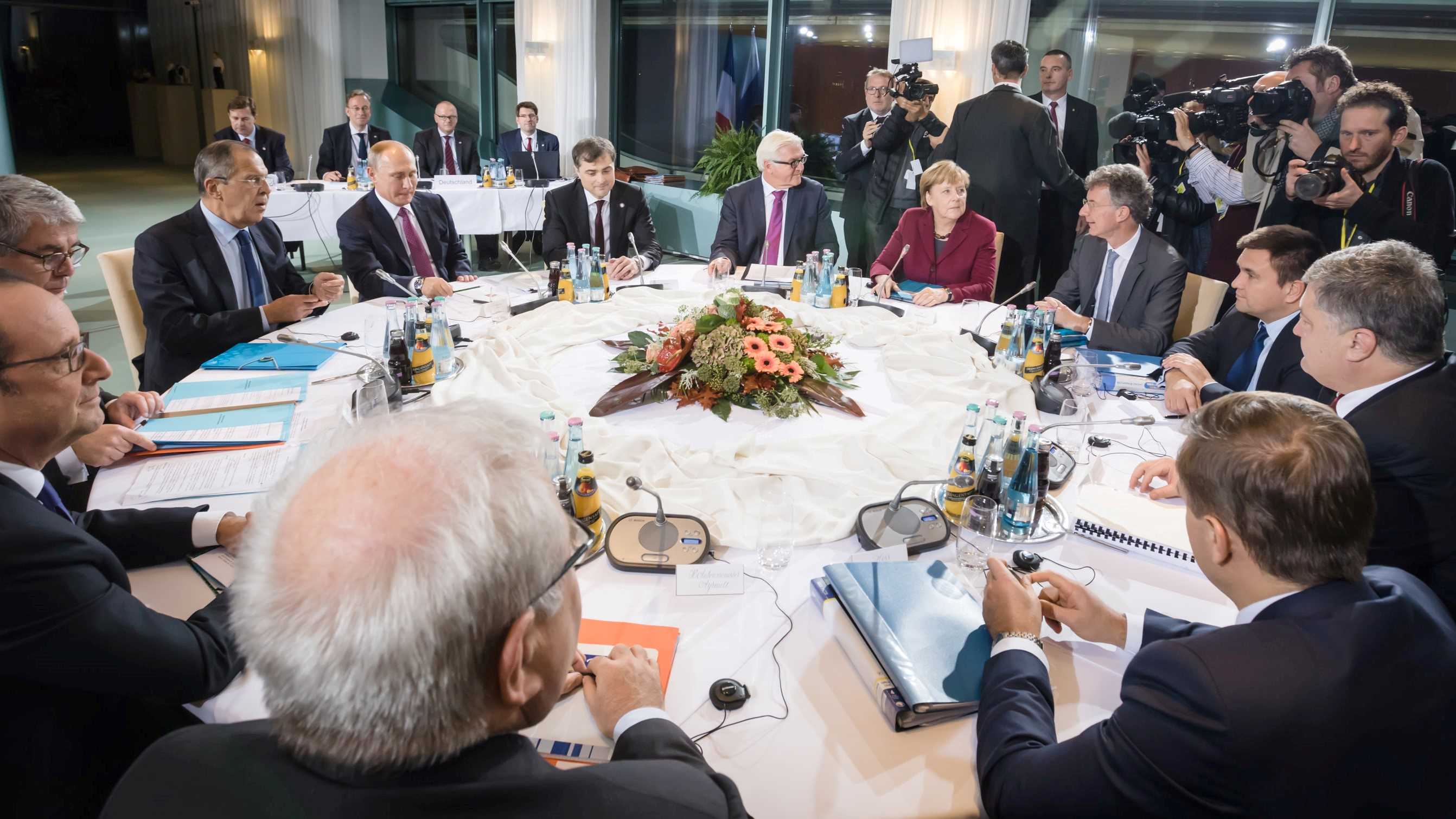 Oct. 19, 2016: German Chancellor Angela Merkel, Russian President Vladimir Putin, Ukrainian President Petro Poroshenko, and French President Francois Hollande meet in Berlin for a summit in the so-called Normandy format on the peace process in eastern Ukraine. (Image: ©palinchak/123RF.COM)
Oct. 19, 2016: German Chancellor Angela Merkel, Russian President Vladimir Putin, Ukrainian President Petro Poroshenko, and French President Francois Hollande meet in Berlin for a summit in the so-called Normandy format on the peace process in eastern Ukraine. (Image: ©palinchak/123RF.COM) “In the period from Stalin to Putin, Russian imperialism has repeatedly set its sights on reconquering Ukraine, annexing it to Russia, and using it as a starting point for further major operations against Poland or other parts of Europe.” (Otto von Habsburg 2006)
The preceding quotation from the clear-sighted Otto von Habsburg aptly summarizes Norbert Tofall’s analysis from 2016. We document the latter below because of its continued relevance—in the wake of the threat to Ukraine’s freedom, also a threat to the free West. The captions have been added by the editors of the Austrian Institute, but the text has not been changed. This is courtesy of the Flossbach von Storch Research Institute in Cologne, Germany, where this study was published as “Political Commentary” on October 28, 2016.
Russian foreign policy is an attempt to bring former Soviet republics “home” to the Russian Empire and to regain hegemonic influence over former Warsaw Pact states. The Russian leadership is therefore trying to undermine any political enforcement of the commitments of Western nations to assist Eastern and Central European states. To secure peace, the West must now develop and enforce new strategies of “extended deterrence” in these times of hybrid warfare.
Restoring “Soviet” Russia for the Purpose of Eurasian Hegemony
“While today’s Russia does not have the capacity for large-scale offensives in the western parts of Europe, it does have the capacity to make rapid territorial gains in the Baltic states and in parts of Poland. The Baltic states cannot be defended with current forces; they would be overrun—as ‘war games’ on the American side suggest—in a matter of days.”[1]
This judgment from a recent study by the German Institute for International and Security Affairs (Stiftung Wissenschaft und Politik) becomes especially relevant in light of the following: Russia’s annexation of Crimea; Russia’s covert war in eastern Ukraine; Russia’s intervention in Syria on the side of the dictator Assad; Russian cyberattacks in the U.S. election campaign; Russian support for right-wing and left-wing dissident political movements; and Russia’s reference to its own nuclear destruction capabilities. Without this behavior on Russia’s part, one might well take the view that a potential for conquest only becomes an actual threat to peace when there is also a will to conquer. Unfortunately, given the factual behavior of Russia’s political leadership, this view is unrealistic.
“The Soviet Union has collapsed. But what did the Soviet Union consist of if not Russia? It was just called something else.” (Vladimir Putin 2011).
At least since October 17, 2011, Vladimir Putin has regarded the post-Soviet states as broken-off parts of a single state: “The Soviet Union has collapsed. But what did the Soviet Union consist of if not Russia? It was just called something else.”[2] And as early as 1994, at the 101st Bergedorfer Gesprächskreises [Bergedorf Discussion Group] of the Körber-Stiftung [Körber Foundation] in St. Petersburg, Putin (still widely unknown at the time), declared that “Russia, in the interest of general security and peace in Europe, has voluntarily ceded huge territories to the former republics of the Soviet Union, including territories that historically have always belonged to Russia. I am thinking not only of Crimea and northern Kazakhstan, but also of Kaliningrad, for example. The consequence is that now suddenly 25 million Russians are living abroad, and Russia simply cannot afford—if only in the interest of security in Europe—that these people are arbitrarily left to their fate.”[3]
Putin expressed this in the context of issues of dual citizenship and minority protection. How the protection of minorities with Russian ancestry abroad then works in practice was exemplified before Russia’s invasion of Georgia (2008) and Russia’s annexation of South Ossetia with the issuance of Russian passports to the residents of South Ossetia.
“Nonlinear” or “Hybrid” Warfare
However, this approach is only one strategic element in today’s “new wars.”[4] “New wars” are understood to be wars without a formal declaration of war and with fronts that are not always clear. They are often masked proxy wars. In these “new wars,” disputes are simultaneously fomented and denied for weeks at a time.[5]
In early 2013, the journal “Vzlgjad” quoted from a speech by Russian Chief of General Staff Valery Gerasimov, which was delivered at a meeting of the Russian Military Academy in January 2013.[6] Gerasimov stated that through political and economic pressure, massive propaganda, incitement of protests by the local population, covert military assets and special forces, today even a “thriving state can be turned into a bitter conflict in the course of months and sink into chaos, humanitarian disaster and civil war.”[7] Russia calls this “nonlinear warfare”; NATO calls it “hybrid warfare.”[8] Moreover, on October 4, 2011, Putin announced his plan to establish a Eurasian Union, creating a powerful supranational community as one of the poles of today’s world.[9] But without Ukraine, Putin’s Eurasian Union remains a paper tiger.
Today’s Russian foreign policy is therefore not a reaction to the encirclement of Russia by hostile powers, but a practical attempt by the Russian leadership to bring former Soviet republics home to the Russian Empire and regain hegemonic influence over former Warsaw Pact states.
While many Western statesmen ignored this matter until the spring of 2014, Otto von Habsburg (1912 – 2011) constantly warned against Putin’s policy in the last ten years of his life: “In the period from Stalin to Putin, Russian imperialism has repeatedly set itself the goal of reconquering Ukraine, annexing it to Russia, and using it as a starting point for further large-scale operations against Poland, or rather the other parts of Europe.”[10]
Today’s Russian foreign policy is therefore not a reaction to the encirclement of Russia by hostile powers,[11] but a practical attempt by the Russian leadership to bring former Soviet republics home to the Russian Empire and regain hegemonic influence over former Warsaw Pact states.
Undermining the Credibility of Western Deterrence
This attempt can succeed in the medium and long term only if Russia can prevent the West from integrating today’s Central and Eastern European states into a credible military strategy of “extended deterrence.” It is not only the Baltic states that cannot effectively defend themselves and thus depend on the “extended deterrence” that comes from credible military assistance from Western NATO allies. Therefore, Russian leadership uses every opportunity it can to undermine the credibility of “extended deterrence.”
The Russian regime under Putin directly and indirectly supports Donald Trump in the United States. Trump has publicly questioned U.S. readiness to stand by NATO partner countries, which is tantamount to questioning “extended deterrence.” Moreover, the Russian regime under Putin supports both right-wing and left-wing dissident populists everywhere in Europe. These have the potential for political and social destabilization through polarization and through opposition to globalization and international cooperation. It is thus becoming increasingly difficult to politically implement military strategies of “extended deterrence.”
Putin has already prevented Ukraine’s integration into a strategy of “extended deterrence” through the annexation of Crimea and his covert war in eastern Ukraine. Putin’s reconciliation with Erdogan in recent weeks [note, 2016] is aimed at splitting NATO. And Putin has as little interest in peace in Syria as he does in resolving the Ukraine conflict. Since Russia’s military intervened, the Syrian conflict has generated increased flows of refugees, which put Europe and the EU under enormous political pressure.
Europe is in the worst possible shape due to the refugee crisis, which can only be overcome by effective control of the internal borders within the EU or the EU’s external borders, and due to the unresolved euro crisis.
Europe is in the worst possible shape: the unresolved euro crisis stands alongside the refugee crisis, which can only be overcome by effective control of the internal borders within the EU or the EU’s external borders. The euro has turned out to be a highly unsuitable means of promoting the peaceful growth of integration among the peoples of Europe. Never has the strife within the EU and especially between the euro countries been greater than in the still-unresolved euro crisis. And the refugee crisis has more than merely driven a wedge between the Visegrad countries and other EU states. The UK’s exit from the EU is the most far-reaching consequence of both crises, which have escalated into a European constitutional crisis. And in the U.S., political and social polarization is likely to continue to grow regardless of the outcome of the next presidential election.
Through these channels, Putin’s regime will continue to exploit this situation in the West to stir up dissension between and within NATO countries. This is because, according to Russia’s new military doctrine of December 25, 2014, NATO and the United States pose a military threat to Russia: first, through possible expansions of NATO by gaining new members as well as through measures to reassure allies that border Russia; and second, through the development of a missile defense system at the nuclear strategic level and through non-nuclear strategic weapons, as well as through capabilities for cyberwarfare.[12]
In Western societies—primarily in Western European societies—there must be a renewed willingness to take military action to defend their own liberal social order.
In view of this hostile threat assessment, an adequate response by the West requires more than just the dissolution of the current polarizations in Western societies. In Western societies—primarily in Western European societies—there must also be a renewed willingness to take military action to defend their own liberal social order. A credible and effective concept of “extended deterrence” for securing peace throughout Europe and the North Atlantic is based on internal Western preconditions, which have themselves been largely denied in Western societies for some time.
The Putin regime, on the other hand, has long recognized that the “dictatorship of relativism” has undermined both the liberal foundations of the West and the will to defend the liberal democratic social order. For this reason, the Putin regime supports all movements from the right or the left that elevate their criticism of conditions in Western societies to criticism of the entire system. Societies polarized by systemic issues increasingly relativize the ethical foundations of law and freedom, thereby gradually destabilizing themselves and losing the strength to defend their own social order and that of their allies. The Putin regime has recognized that it is questionable whether Western societies currently have the strength and ability to face up to the military strategic issues at hand.
The Illusion of an Unarmed Peace—and the Toothlessness of Economic Sanctions
Large parts of Western European societies today are trapped in an illusion that can be described as “peacemaking without weapons.” This illusion was heightened for many people by the fall of the Iron Curtain in 1989-90, even though the collapse of real-existing socialism and the Warsaw Pact was based not least on the enforcement of the NATO Double-Track Decision and thus on the stationing of nuclear weapons and an arms race that ultimately led the socialist central administrative economies to collapse.
The enforcement of the NATO Double-Track Decision had the effect of depriving the Soviet Union and its satellites of the possibility of reducing pressures to solve their socio-economic problems through territorial expansion, and at a reasonable cost that was justifiable to the Soviet leadership. “Reasonable” in this context means the costs that follow from conventional military confrontation; “unjustifiable” means the costs of nuclear confrontation, because it would lead to self-destruction.
The deployment of Soviet SS-20 medium-range missiles armed with nuclear warheads in the mid-1970s jeopardized NATO’s “extended deterrence” and thus the strategic security balance in Europe. It was considered uncertain whether the United States would respond to a Warsaw Pact attack on Western Europe with intermediate-range nuclear missiles by launching nuclear-capable intercontinental ballistic missiles. On the decisive initiative of German Chancellor Helmut Schmidt (SPD), NATO decided in Brussels on December 12, 1979, to deploy intermediate-range nuclear missiles in Europe (Pershing II and Cruise Missile) to restore the strategic security balance in Europe.
At the same time, the Warsaw Pact, led by the Soviet Union, was offered negotiations to disarm its SS-20 missiles, from which the name Double Decision derives. If these negotiations failed, NATO would deploy intermediate-range nuclear missiles in Europe. The negotiations failed. The Pershing II and cruise missile were deployed. The military-industrial complex of real-existing socialism reached its limits. The collapse of real-existing socialism and the Warsaw Pact could not be stopped even by glasnost and perestroika.
The peace since 1989-90 and before was not based on weaponlessness. Peace was created and maintained by weapons, because the West dared to consistently oppose a potential for conquest by the “East.”
Peace since 1989-90 and before was therefore not based on a lack of weapons. Peace was created by weapons and maintained by weapons because the West dared to consistently oppose a potential for conquest by the “East” and to close strategic security gaps.
Furthermore, today’s strategic security gaps will certainly not be closed by economic sanctions. In the Ukraine crisis, massive sanctions against Russia have indeed led to enormous economic damage in Russia as well as in Europe and the United States. However, the sanctions have so far not brought about any change in Russian policy. Russia has not returned to the basis of the Helsinki Final Act because of the sanctions but is bracing itself for a decade of sanctions. Russia has not changed its policy toward Ukraine. The military adventure of a covert war in the east and south of Ukraine has not been stopped despite temporary ceasefires. Crimea has not been returned. In view of its mode of waging war in Syria, Russia will not be persuaded to change its Syria policy even because of possible sanctions.[13]
Unfortunately, unilateral “peacemaking without weapons” does not lead to peace but increases the danger of new wars. Those who seriously want “peace for our time” must engage in strategies of military deterrence and strategic security balances.
Building New Deterrence Capabilities?
“While today’s Russia does not have the capacity for large-scale offensives in the western parts of Europe, it does have the capacity to make rapid territorial gains in the Baltic states and in parts of Poland. The Baltic states cannot be defended with current forces; they would be overrun-as ‘war games’ on the American side suggest—in a matter of days.”[14]
Given Russia’s potential for military conquest and the resulting strategic security gap, the peacekeeping goal of NATO and the U.S. can only be to deter Russia at the outset from “large-scale offensives” and the realization of “rapid territorial gains” in eastern Poland and the Baltics. NATO and the United States face a choice of two strategic options for deterrence in this situation.
First, conventional NATO multinational forces and weapons could be permanently deployed on a significant scale in the Baltics and Poland, far beyond the multinational battalions on a rotational basis agreed to at the July 2016 NATO Warsaw Summit. Second, NATO and the United States could threaten nuclear retaliation in the event of a conventional attack on the Baltics and Poland, or expand the conventional military conflict geographically,[15] which would mean threatening full-scale war in Central and Eastern Europe.
The first option would not only be a violation of the 1997 NATO-Russia Founding Act, but the deployment of conventional multinational NATO forces in the Baltic States and Poland—far exceeding the size of the multinational battalions already decided upon on a rotational basis—would lead to a real threat to St. Petersburg and Königsberg and would therefore likely increase the risk of war. The goal, however, is peacekeeping.
The second option is very difficult, if not impossible to implement in Western societies. Moreover, it leads to a similar strategic security gap as in the 1970s. Is it certain that the other NATO countries will respond to a Russian conventional attack on the Baltics and Poland with nuclear retaliation or full-scale conventional war in Central and Eastern Europe?[16] Certainly not! But how could this security gap—at least theoretically—be closed quickly? And this gap must be closed quickly for peacekeeping reasons.
Can Leaders Close the Strategic Security Gap as Happened in the Late 1970s and Early 1980s?
Moreover, the question arises as to what form of deterrence could deter Russia from “hybrid warfare” in the Baltic states. At present, there is a real danger that Putin will feel emboldened to destabilize the Baltics by instrumentalizing the Russian minority in Estonia (25% of the population), the Russian minority in Latvia (29% of the population), or the Russian minority in Lithuania.
Since Russia could justifiably feel threatened by the massive permanent stationing of conventional NATO troops, and since the threat of nuclear retaliation on the part of Western NATO countries is uncertain and thus not very credible, nuclear weapons could be stationed on the territory of threatened states, similar to what happened in the 1970s, in order to close the strategic security gap that has been opened up. Such a deployment would require the denunciation of the 1997 NATO-Russia Founding Act, but it would have the advantage for Russia that no conquerable conventional force formations would threaten Russian territory. No country can be conquered with nuclear weapons. Nuclear weapons “only” deter attacks on Russia’s own territory.
Russia certainly would not have dared to annex Crimea in 2014 if Ukraine still possessed nuclear weapons. The peace between Russia and Ukraine would probably have held. Today, Ukraine seems to be lost.
The extent to which Russia will be deterred from “hybrid warfare” by nuclear weapons in the Baltic States and in Poland remains an open question. However, the risk that “hybrid warfare” could escalate to nuclear warfare is likely to prompt the Russian leadership to make other trade-offs based on the cost and the risk. Russia certainly would not have dared to annex Crimea in 2014 if Ukraine still possessed nuclear weapons. The peace between Russia and Ukraine would probably have held. Today, Ukraine appears to be doomed.
However, the nuclear deterrent option, to close broken security gaps quickly and effectively, which is obvious in theory, is likely to face at least two resistances in practice. First, the nuclear deterrent option is difficult and probably politically impossible to implement because of Western Europe’s low will to defend itself, as discussed above, and the highly polarized social situation in Western societies. Second, the U.S. is unlikely to be willing to put nuclear weapons in the hands of the Baltics and Poland thereby placing them under the command of Baltic and Polish governments. But would the U.S. government be willing to place nuclear weapons there under its own command and make a credible case that these weapons would be used in an emergency? The Obama administration’s Syria policy casts doubt on this.
Creating New Strategies of “Extended Deterrence” for Peacekeeping in Europe
The rotating multinational battalions of conventional forces for the Baltic States and eastern Poland agreed upon at the Warsaw NATO summit in July 2016 are a major step forward compared to the previous situation, even if they can only close the security gap to a very limited extent. In any case, the proportion of U.S. soldiers in these multinational battalions should be as high as possible, because this is the only way to increase the probability that the United States will immediately launch escalation steps in the event of an attack on these battalions. “Hybrid warfare” by Russia in the Baltics cannot be prevented by these multinational battalions, but they can increase the associated risk for Russia.
It is time for the West to develop new strategies of “extended deterrence” to secure peace in Europe and to close the security gaps that have been opened. Since Russia has repeatedly pointed out its nuclear destruction capability, the West cannot ignore the nuclear deterrence option in the long run. Unfortunately, unilateral “peacemaking without weapons” does not lead to peace but increases the danger of new wars. And what we need now is peace.
Notes
[1] Peter Rudolf: Amerikanische Russland-Politik und europäische Sicherheitsordnung, SWP-Studie (Berlin: September 2016), 20 – 21.
[2] This was Putin’s statement in an interview with three major Russian TV channels, quoted by Vladislav Inosemtsev and Ekaterina Kuznetsova: “Putins unnützes Spielzeug. Moskaus Eurasische Union ist Ausdruck geopolitischen Wunschdenkens,” Internationale Politik 1 (January/February 2012), 78 – 87, at 80.
[3] Minutes of the 101st Bergedorfer Gesprächskreises [Bergedorf Discussion Group] of the Körber-Stiftung [Körber Foundation], p. 38. (Accessed February 2, 2022).
[4] In general, concerning “new wars,” see Herfried Münkler, Die neuen Kriege (Reinbeck [Rowohlt]: 2002).
[5] See Michael Roick, Lebt Putin in einer “anderen Welt”? Ein Versuch, die russische Außenpolitik zu verstehen (Potsdam: Friedrich-Naumann-Stiftung für die Freiheit, 2014), 8 (accessed February 2, 2022).
[6] I would like to thank Dr. Christian Wipperfürth of the German Council on Foreign Relations for this reference. It was erroneously reported in Western media and has since been repeatedly cited that Valery Gerasimov had written an essay in the journal Militärisch-Industrieller Kurier.
[7] Ibid, p. 8; Roick here cites the article “Die Welt in Scherben” (The World in Shards) from the Süddeutsche Zeitung of July 19, 2014. This and other citations are also referred to in Thomas Gutschker, “Putins Schlachtplan,” in Frankfurter Allgemeine Sonntagszeitung of September 7, 2014.
[8] See Thomas Gutschker, “Putins Schlachtplan.”
[9] See Wladislaw Inosemzew and Ekaterina Kusnezowa, “Putins unnützes Spielzeug. Moskaus Eurasische Union ist Ausdruck geopolitischen Wunschdenkens,” 82.
[10] Otto von Habsburg, Unsere Welt ist klein geworden. Die Globalisierung der Politik (Vienna: Amalthea, 2006), 115. See also Bianka Pietrow-Ennker and Benno Ennker, “Ein Reich mit Mission,” Frankfurter Allgemeine Zeitung (May 12, 2014), n. 109, p. 6: “Moscow’s actions in the Ukraine crisis follow traditions and patterns of imperial politics that have been mapped out by Russian rulers from Ivan the Terrible to Stalin” (translation).
[11] The encirclement theory has been popularized in particular by Peter Scholl-Latour. See Peter Scholl-Latour, Russland im Zangengriff. Putins Imperium zwischen Nato, China und Islam (Berlin: Ullstein, 2006).
[12] See Peter Rudolf, Amerikanische Russland-Politik, 12; similarly, Margarte Klein, “Russlands neue Militärdoktrin. Nato, USA und ‘farbige Revolutionen’ im Fokus” SWP-Aktuell (February 12, 2015).
[13] See also Norbert F. Tofall, “Ziele und Wirksamkeit von Wirtschaftssanktionen. Eine Betrachtung hinsichtlich des Russland-Ukraine-Konflikts,” Flossbach von Storch Research Institute, Makroanalyse 2/2015 (accessed February 2, 2022).
[14] Peter Rudolf, “Amerikanische Russland-Politik und europäische Sicherheitsordnung,” SWP-Studie (Berlin: September 2016), 20 – 21.
[15] Cf. Peter Rudolf, “Amerikanische Russland-Politik und europäische Sicherheitsordnung,” 21f.
[16] Moreover, the question of whether the NATO countries, due to their shrunken military units, are at all in a position, in terms of their equipment, to credibly threaten a full-scale war in Central and Eastern Europe should not be neglected.



